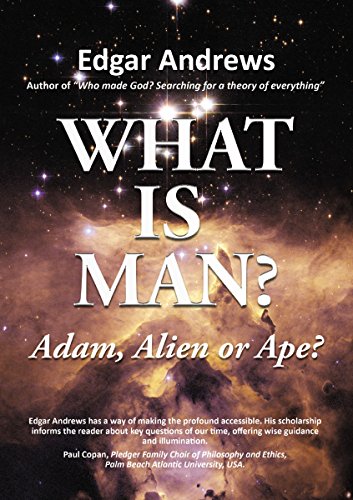The Writing Apologetic* Ministry of Edgar Andrews
*Apologetic: Here meaning having to do with the defense of, or reason for, the faith that one holds.
 I first met Professor Edgar Andrews in 1999. I recall him, distinguished, articulate, erudite—in many ways, just what you might expect a professor to be. At the time, he was chairman of Evangelical Times and Evangelical Press. I had just relocated to England and was finding my feet in a new climate, adjusting to a new work situation, meeting new friends, discovering the joys of navigating around English traffic roundabouts (“Who gives way to whom, or do you just pray and take a chance?”) and experiencing many other new things. Our pathways would cross at occasional board meetings and when he would come to the Faverdale office in Darlington to oversee the production of the monthly paper.
I first met Professor Edgar Andrews in 1999. I recall him, distinguished, articulate, erudite—in many ways, just what you might expect a professor to be. At the time, he was chairman of Evangelical Times and Evangelical Press. I had just relocated to England and was finding my feet in a new climate, adjusting to a new work situation, meeting new friends, discovering the joys of navigating around English traffic roundabouts (“Who gives way to whom, or do you just pray and take a chance?”) and experiencing many other new things. Our pathways would cross at occasional board meetings and when he would come to the Faverdale office in Darlington to oversee the production of the monthly paper.
We enjoyed good interactions whenever we met. I knew Prof. Andrews was much more than a brain on legs, but I always felt somewhat in awe of his great intellect—a man who knew so much about the science of materials, and yet who was at home with English literature, history, theology, ancient Greek, and many other disciplines.
I had first known of him through various of his writings, and in South Africa had enjoyed selling his books in several of my sales initiatives through Reformation Heritage Trust, subsequently renamed Barnabas Book Room. Always solid in their content, always clearly written, always with modern application, his books resonated with me and with the reading clientele Sue and I served…
So when Edgar contacted me again some years after I moved to the USA, I was delighted to have the opportunity of working with him again on some new projects. One of his earlier publications, Who Made God?, had captured the imagination of the reading public, selling tens of thousands of copies. “I’ve been working on a new book, one on the origin of man, titled What is Man—Adam, Alien or Ape?—do you think you could help promote it?” Edgar asked me. His explanatory email was predictably through in his description of the text and his plans for promoting it internationally. Of course, I was delighted to do so, and once it was in print, it was my pleasure to review it in these words—which you may read on Amazon HERE. (It’s a very good book—as I think you will see from my review notes.)
My Amazon Review Notes
A sequel to his bestselling book, “Who Made God?”, Edgar Andrews’ book “What is Man?” is a carefully thought-through, well prepared, wittily and engagingly written piece.
The author’s background in both arts and science (he is a well-rounded intellectual) eminently qualifies him to write both at length and in depth in areas of science, philosophy, literature, art, and the Christian faith—the latter from a well-informed perspective of faith. He engages robustly with some important minds along the way.
While Professor Andrews might be described as a “brain on legs,” he is a very capable communicator, taking complex concepts and subjects, breaking them down into bite-sized examples, making judicious use of illustrations to simplify them (yet without being simplistic) and then drawing lines of application to modern life and especially in challenging the thinking of people who may have mistakenly and uncritically imbibed the presuppositions and worldview of a generation who have more often been informed by talk-shows and TV than by well-reasoned scientific disciplines and carefully considered theological and philosophical conclusions.
To sketch the book by way of overview, Professor Andrews takes readers, as it were, by the hand (never condescendingly) and guides them page by page, step by step, idea by idea, through a maze of considerations considered within three categories: Man and the Cosmos, Man and the Biosphere, and Man and the Bible.
Under the first part, (Man and the Cosmos) the author gives consideration to key concerns such as the identity of humankind, the impossibility of the universe being self-creating, the willful conjecture of the media in inventing and embellishing highly detailed “facts” when there is no undergirding evidence, the habitability of the world (what he refers to as a fine-tuned universe) and the difficulties posed by the conceptualization of a multiverse.
Part 2 (Man and the Biosphere) considers people as unique creatures, traces the ramifications of the complexity of genetic mapping, spends some time on speculations that have arisen in light of fossil research and dating, and rounds off with some philosophical and ontological sketches with respect to human consciousness.
The third part of “What is Man?” (Man and the Bible) begins to draw many of the ideas heretofore explored into a unified conclusion, and provides a probing analysis of worldviews, the historicity of the fall of our first parents, the imago dei, Christ as the Second Adam, and the undeniability of the resurrection of Jesus.
Is this a “preaching, condescending kind of book”? I didn’t find it so. The author’s calm writing style, his eloquence, his gentle wit—these are all engaging features. In it all, I felt he was letting his readers come to their own conclusions at their own speed. Truth is compelling. Truth has the power, under God, to be life-transforming. This is the kind of book most people will easily be able to read. Be sure you are one of them and get one—and an extra one or two, too, for a family member or work colleague whom you might like to challenge to rethink some aspects of life!
Other Writings of Professor Edgar Andrews
 I have worked with Edgar in lightly editing, reformatting, and republishing his most helpful book on Galatians (EP Books used to have it in the Welwyn Commentary Series—though Great Writing Publications it is titled Free in Christ—The Message of Galatians for Today) (more about that in another blog entry another time) and it’s on my radar soon to have his excellent commentary on Hebrews—A Glorious High Throne—back in print, also in the Great Writing Publications imprint.
I have worked with Edgar in lightly editing, reformatting, and republishing his most helpful book on Galatians (EP Books used to have it in the Welwyn Commentary Series—though Great Writing Publications it is titled Free in Christ—The Message of Galatians for Today) (more about that in another blog entry another time) and it’s on my radar soon to have his excellent commentary on Hebrews—A Glorious High Throne—back in print, also in the Great Writing Publications imprint.











 The cover design of the book caught my eye as well as the title. “Who Moved My Cheese?” it asked. It was a slender volume, no more than 96 pages as I recall, and it told the story of a number of mice that had to face change in life. The longstanding supply of cheese from which they have helped themselves is no more. “What is to be done in securing more cheese?” is the challenge facing these four mice. Written as a parable that takes place in a maze, the story engagingly describes Sniff and Scurry, and their associates, Hem and Haw, and how they go about finding more cheese. Spencer Johnson’s intention is to introduce readers to the concept of positive change and how to cope with it. The book makes for engaging reading.
The cover design of the book caught my eye as well as the title. “Who Moved My Cheese?” it asked. It was a slender volume, no more than 96 pages as I recall, and it told the story of a number of mice that had to face change in life. The longstanding supply of cheese from which they have helped themselves is no more. “What is to be done in securing more cheese?” is the challenge facing these four mice. Written as a parable that takes place in a maze, the story engagingly describes Sniff and Scurry, and their associates, Hem and Haw, and how they go about finding more cheese. Spencer Johnson’s intention is to introduce readers to the concept of positive change and how to cope with it. The book makes for engaging reading. The “Big A” has changed a lot of things. At one time, nobody took Amazon too seriously, but not so anymore. Amazon’s ability to operate on a relatively low overhead and to have negotiated specially preferential, volume-related relationships with shippers has dealt the death knell to many vendors who had maybe become comfortable with the status quo. The reality is that people’s buying habits have changed and continue to do so. Most people today are quite relaxed in making online purchases.
The “Big A” has changed a lot of things. At one time, nobody took Amazon too seriously, but not so anymore. Amazon’s ability to operate on a relatively low overhead and to have negotiated specially preferential, volume-related relationships with shippers has dealt the death knell to many vendors who had maybe become comfortable with the status quo. The reality is that people’s buying habits have changed and continue to do so. Most people today are quite relaxed in making online purchases.



 One of the many things I get to enjoy is working with gifted authors.
One of the many things I get to enjoy is working with gifted authors.



Recent Comments